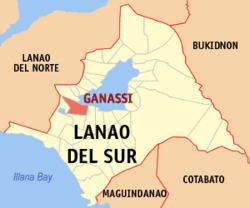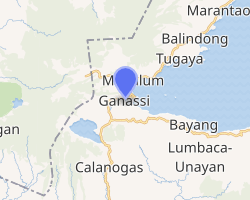Ganassi, Lanao del Sur
Ganassi, officially the Municipality of Ganassi (Maranao: Inged a Ganassi; Tagalog: Bayan ng Ganassi), is a 4th class municipality in the province of Lanao del Sur, Philippines. According to the 2015 census, it has a population of 23,016 people.[3]
Ganassi | |
|---|---|
| Municipality of Ganassi | |
 Map of Lanao del Sur with Ganassi highlighted | |
OpenStreetMap 
| |
.svg.png) Ganassi Location within the Philippines | |
| Coordinates: 7°49′37″N 124°06′12″E | |
| Country | |
| Region | Bangsamoro Autonomous Region in Muslim Mindanao (BARMM) |
| Province | Lanao del Sur |
| District | 2nd District |
| Barangays | 32 (see Barangays) |
| Government | |
| • Type | Sangguniang Bayan |
| • Mayor | Hosni B. Macapodi |
| • Vice Mayor | Al-rashid B. Macapodi |
| • Congressman | Yasser A. Balindong |
| • Electorate | 9,213 voters (2019) |
| Area | |
| • Total | 256.00 km2 (98.84 sq mi) |
| Population (2015 census)[3] | |
| • Total | 23,016 |
| • Density | 90/km2 (230/sq mi) |
| • Households | 2,390 |
| Economy | |
| • Income class | 4th municipal income class |
| • Poverty incidence | 63.15% (2015)[4] |
| • Revenue (₱) | 81,558,561.61 (2016) |
| Time zone | UTC+8 (PST) |
| ZIP code | 9311 |
| PSGC | |
| IDD : area code | +63 (0)63 |
| Climate type | tropical climate |
| Native languages | Maranao Tagalog |
| Website | www |
The municipality used to host the 'finest example of a traditional torogan' according to Dr. Jesus T. Peralta of the National Commission for Culture and the Arts. In January 2016, a media team found that the Laguindab torogan still stands in Ganassi, though it is badly damaged. A conservation effort is needed to rehabilitate the Laguindab torogan, one of the most outstanding royal houses built in the entire Philippines.
Barangays
Ganassi is politically subdivided into 32 barangays.
- Bagoaingud
- Balintad
- Barit
- Bato Batoray
- Campong a Raya
- Gadongan
- Gui
- Linuk
- Lumbac
- Macabao
- Macaguiling
- Pagalongan
- Panggawalupa
- Pantaon A
- Para-aba
- Pindulonan
- Poblacion
- Baya
- Sogod Madaya
- Tabuan
- Taganonok
- Taliogon
- Masolun
- Lumbacaingud
- Sekun Matampay
- Dapaan
- Balintad A
- Barorao
- Campong Sabela
- Pangadapan
- Pantaon
- Pamalian
Climate
| Climate data for Ganassi, Lanao del Sur | |||||||||||||
|---|---|---|---|---|---|---|---|---|---|---|---|---|---|
| Month | Jan | Feb | Mar | Apr | May | Jun | Jul | Aug | Sep | Oct | Nov | Dec | Year |
| Average high °C (°F) | 26 (79) |
26 (79) |
26 (79) |
27 (81) |
26 (79) |
25 (77) |
25 (77) |
25 (77) |
25 (77) |
25 (77) |
25 (77) |
26 (79) |
26 (78) |
| Average low °C (°F) | 20 (68) |
20 (68) |
20 (68) |
21 (70) |
21 (70) |
21 (70) |
20 (68) |
20 (68) |
20 (68) |
20 (68) |
21 (70) |
20 (68) |
20 (69) |
| Average precipitation mm (inches) | 236 (9.3) |
225 (8.9) |
244 (9.6) |
235 (9.3) |
304 (12.0) |
287 (11.3) |
200 (7.9) |
175 (6.9) |
158 (6.2) |
200 (7.9) |
287 (11.3) |
243 (9.6) |
2,794 (110.2) |
| Average rainy days | 24.3 | 22.3 | 26.0 | 27.2 | 28.3 | 27.2 | 25.8 | 24.8 | 22.2 | 25.4 | 27.2 | 25.8 | 306.5 |
| Source: Meteoblue [5] | |||||||||||||
Demographics
| Year | Pop. | ±% p.a. |
|---|---|---|
| 1918 | 1,943 | — |
| 1939 | 3,892 | +3.36% |
| 1948 | 9,573 | +10.52% |
| 1960 | 12,372 | +2.16% |
| 1970 | 13,227 | +0.67% |
| 1975 | 15,506 | +3.24% |
| 1980 | 9,755 | −8.85% |
| 1990 | 15,394 | +4.67% |
| 1995 | 16,947 | +1.82% |
| 2000 | 18,947 | +2.42% |
| 2007 | 25,456 | +4.16% |
| 2010 | 20,205 | −8.06% |
| 2015 | 23,016 | +2.51% |
| Source: Philippine Statistics Authority[3][6][7] | ||
History
Ganassi among to the Nine Princess of Unayan (e.g. in Meranau term Inuda so Ganassi Ayour so Linindingan,Andong so Macadar, etc.)
Torogan Finesse
It was reported in 2015 that the town once hosted what used to be the finest example of a torogan, a huge traditional Maranao house which was the seat of power of the Maranao royalties and Maranao high officials. Unfortunately, for an undisclosed reason, the torogan was demolished by some locals. A group once campaigned for the passage of an ordinance where the architecture of all houses and buildings in Ganassi will follow the okir and the torogan style. Through it, the town would have been the first planned city whose architectural grandeur is inspired by a traditional Maranao vernacular way of building. However, due to lack of funding available, the campaign went into deaf ears.
In January 2016, the media team went to the municipality and found half of the former Laguindab Torogan of Ganassi still intact and badly needs restoration. Once restored, according to the National Commission for Culture and the Arts, the Laguindab Torogan can be declared as a National Cultural Treasure like the Kawayan torogan of Marantao. A group of people are planning to nominate the torogans of Lanao del Sur to the UNESCO World Heritage List, but the nomination is being halted as of the moment due to the lack of restoration in some torogans in the area, specifically in Ganassi. The possible nomination of the Laguindab torogan to the National Cultural Treasure list and the UNESCO list is seen to boost the tourism of the area, if the torogan is conserved properly and evaluated by the local government of Ganassi, with aid request from the National Museum or National Commission for Culture and the Arts.[8]
References
- "Municipality". Quezon City, Philippines: Department of the Interior and Local Government. Retrieved 31 May 2013.
- "Province: Lanao del Sur". PSGC Interactive. Quezon City, Philippines: Philippine Statistics Authority. Retrieved 12 November 2016.
- Census of Population (2015). "ARMM – Autonomous Region in Muslim Mindanao". Total Population by Province, City, Municipality and Barangay. PSA. Retrieved 20 June 2016.
- "PSA releases the 2015 Municipal and City Level Poverty Estimates". Quezon City, Philippines. Retrieved 12 October 2019.
- "Ganassi, Lanao del Sur : Average Temperatures and Rainfall". Meteoblue. Retrieved 24 January 2019.
- Census of Population and Housing (2010). "ARMM – Autonomous Region in Muslim Mindanao". Total Population by Province, City, Municipality and Barangay. NSO. Retrieved 29 June 2016.
- Censuses of Population (1903–2007). "ARMM – Autonomous Region in Muslim Mindanao". Table 1. Population Enumerated in Various Censuses by Province/Highly Urbanized City: 1903 to 2007. NSO.
- https://www.rappler.com/life-and-style/travel/ph-travel/117638-lanao-del-sur-travel-culture
External links